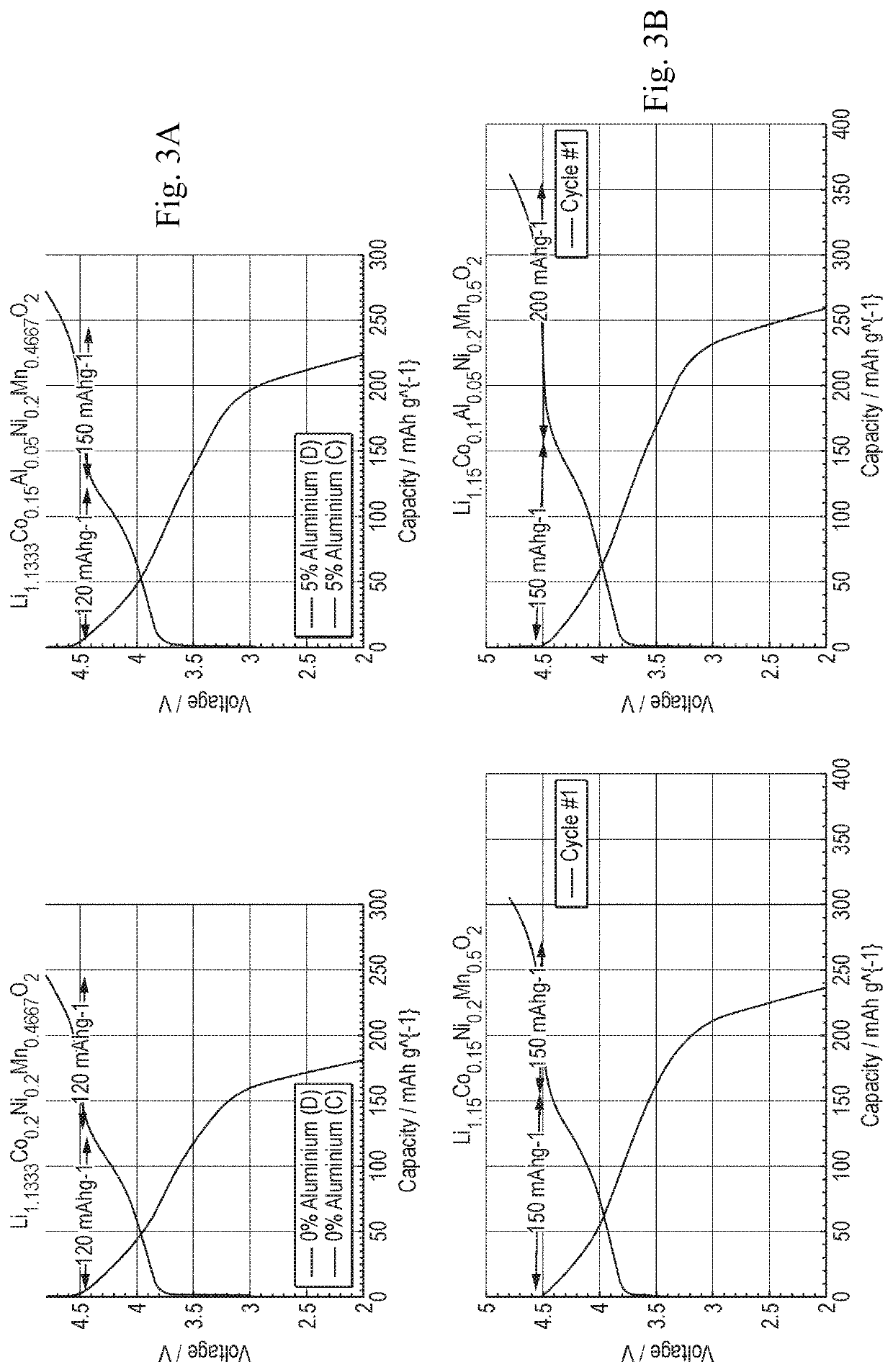Use of aluminum in a lithium rich cathode material for suppressing gas evolution from the cathode material during a charge cycle and for increasing the charge capacity of the cathode material
a cathode material and lithium rich technology, applied in the field of high-capacity lithium rich compounds, can solve the problems of undesired redox reactions which would break down the material, limited performance of conventional lithium ion batteries,
- Summary
- Abstract
- Description
- Claims
- Application Information
AI Technical Summary
Benefits of technology
Problems solved by technology
Method used
Image
Examples
example 1
Synthesis of the Nickel-Cobalt-Aluminium Substituted Lithium Rich Materials
[0029]The Formaldehyde-Resorcinol sol gel synthetic route was employed to synthesise materials with general formula
[0030]Li(43-2x3-y3-z3)NixCoyAlzMn(23-x3-2y3-2z3)O2
with a composition having x=0.2 y=0.15 z=0.05 (composition in FIGS. 1A, 2A, and 3A); and with a composition having x=0.2 y=0.1 z=0.05 (composition in FIGS. 1B, 2B, and 3B).
[0031]All the reagents ratios were calculated in order to obtain 0.01 mol of the final product.
[0032]Stoichiometric amounts of CH3COOLi.2H2O (98.0%, Sigma Aldrich®, (CH3COO)2Mn.4H2O (>99.0%, Sigma Aldrich®, (CH3COO)2Co.4H2O (99.0% Sigma Aldrich®, Al2(SO4)3.4H2O (Sigma Aldrich® and (CH3COO)2Ni.4H2O (99.0% Sigma Aldrich® were dissolved in 50 mL of water with 0.25 mmol of CH3COOLi.2H2O (99.0%, Sigma Aldrich® corresponding to 5% moles of lithium with respect to the 0.01 moles of synthesized material. At the same time 0.1 mol of resorcinol (99.0%, Sigma Aldrich® was dissolved...
example 2
Structural Analysis and Characterisation of the Nickel-Cobalt-Aluminium Substituted Lithium Rich Materials
[0034]The materials according to Example 1 were examined with Powder X-Ray Diffraction (PXRD) which was carried out utilising a Rigaku® SmartLab equipped with a 9 kW Cu rotating anode.
[0035]FIGS. 1A and 1B shows Powder X-ray Diffraction patterns of the synthesised materials. These are characteristic of a layered materials with some cation ordering in the transition layer. All of the patterns appear to show the major peaks consistent with a close-packed layered structure such as LiTMO2 with a R-3m space group. Additional peaks are observed in the range 20-30 2Theta degrees which cannot be assigned to the R-3m space. The order derives from the atomic radii and charge density differences between Li+ (0.59 Å), Ni+2 (0.69 Å) and Mn4+ (0.83 Å) and appears the strongest in the structures of the low nickel doped oxides. The peaks are not as strong as in materials where a perfect order e...
example 3
Electrochemical Analysis of the Nickel-Cobalt-Aluminium Substituted Lithium Rich Materials
[0036]The materials according to Example 1 were characterised electrochemically through galvanostatic cycling performed with a BioLogic VMP3 and a Maccor 4600 series potentiostats. All the samples were assembled into stainless steel coincells against metallic lithium and cycled between 2 and 4.8 V vs. Li+ / Li for 100 cycles at a current rate of 50 mAg−1. The electrolyte employed was LP30 (a 1M solution of LiPF6 in 1:1 w / w ratio of EC:DMC).
[0037]FIGS. 2A-2B and FIGS. 3A-3B show the potential curves during the charge and subsequent discharge of the first cycle for each material according to Example 1 (FIG. 3A-3B includes plots of non-doped aluminium cathode materials as a comparative example). Both samples present a high voltage plateau of different lengths centered on 4.5 V vs. Li+ / Li0, and a sloped region at the beginning of the charge. The length of this region may be attributed to the oxidatio...
PUM
| Property | Measurement | Unit |
|---|---|---|
| w/w | aaaaa | aaaaa |
| voltage | aaaaa | aaaaa |
| structure | aaaaa | aaaaa |
Abstract
Description
Claims
Application Information
 Login to View More
Login to View More - R&D
- Intellectual Property
- Life Sciences
- Materials
- Tech Scout
- Unparalleled Data Quality
- Higher Quality Content
- 60% Fewer Hallucinations
Browse by: Latest US Patents, China's latest patents, Technical Efficacy Thesaurus, Application Domain, Technology Topic, Popular Technical Reports.
© 2025 PatSnap. All rights reserved.Legal|Privacy policy|Modern Slavery Act Transparency Statement|Sitemap|About US| Contact US: help@patsnap.com



